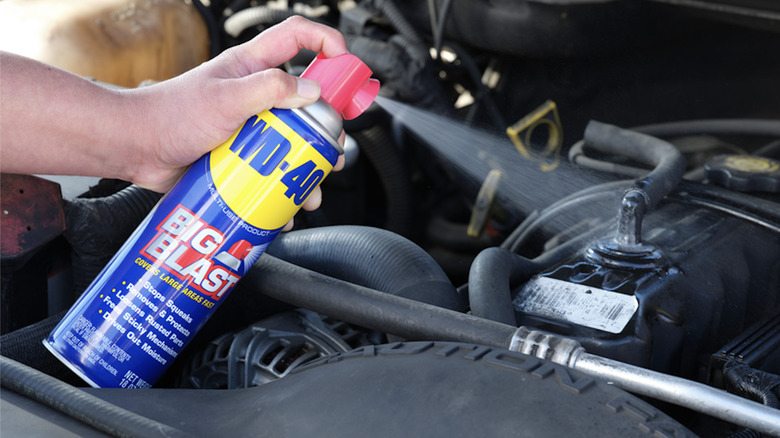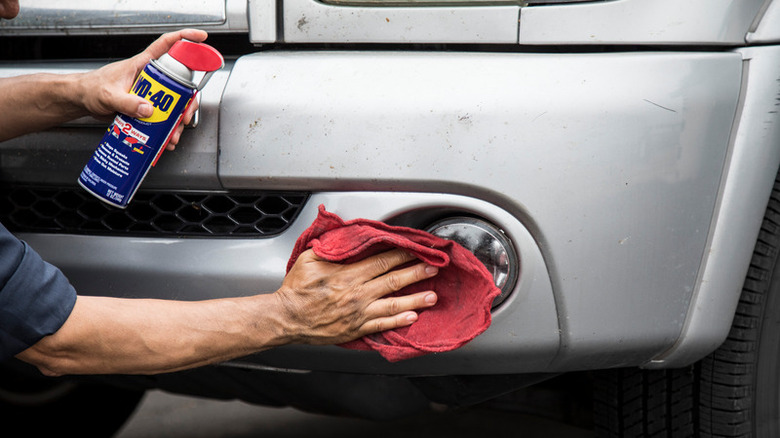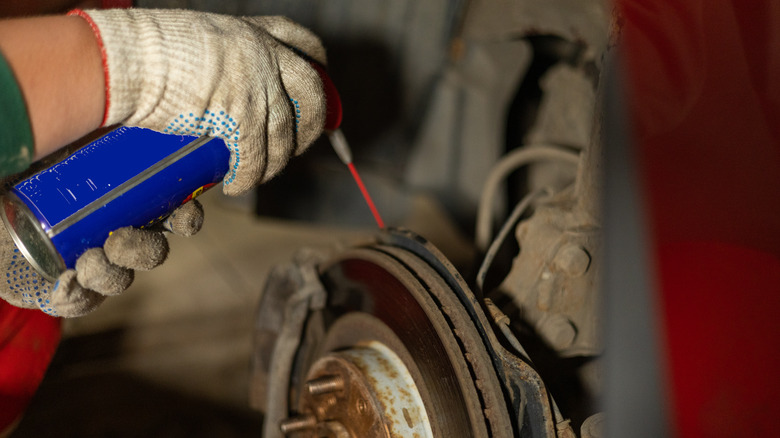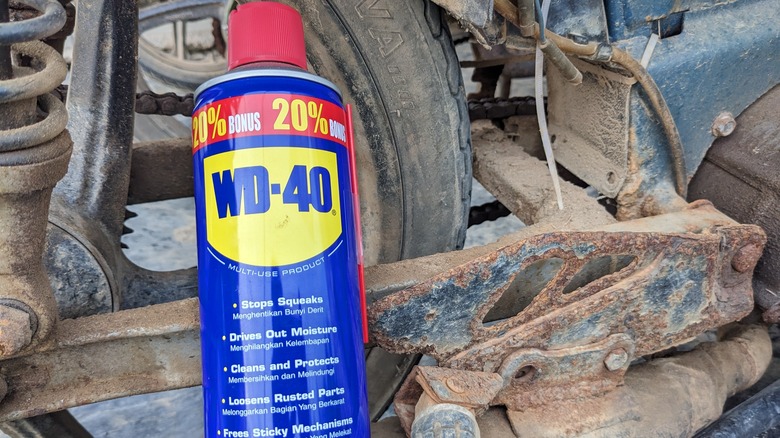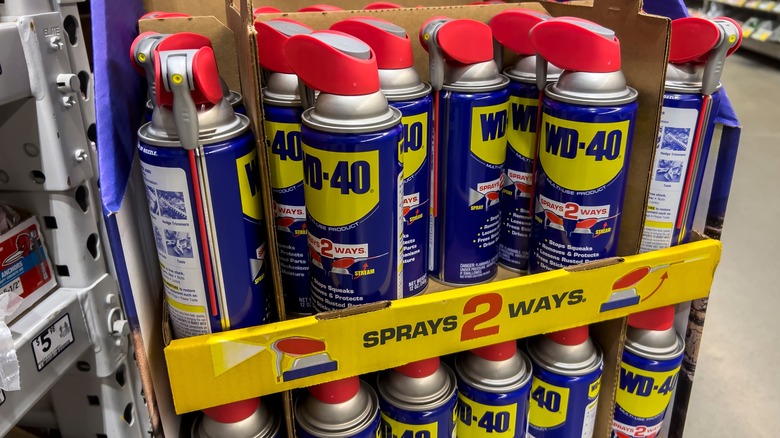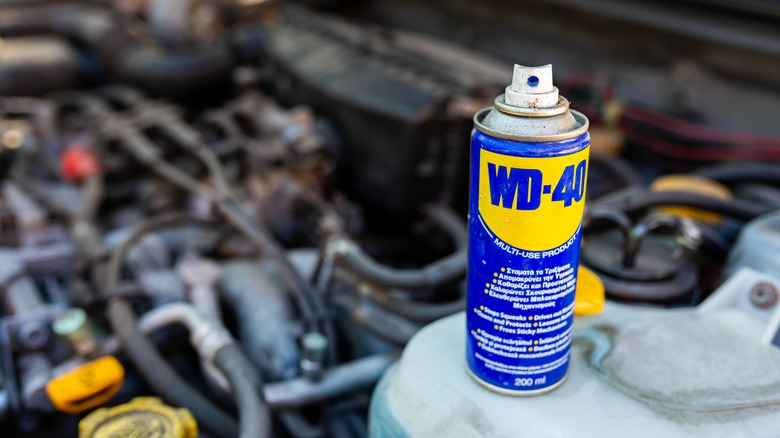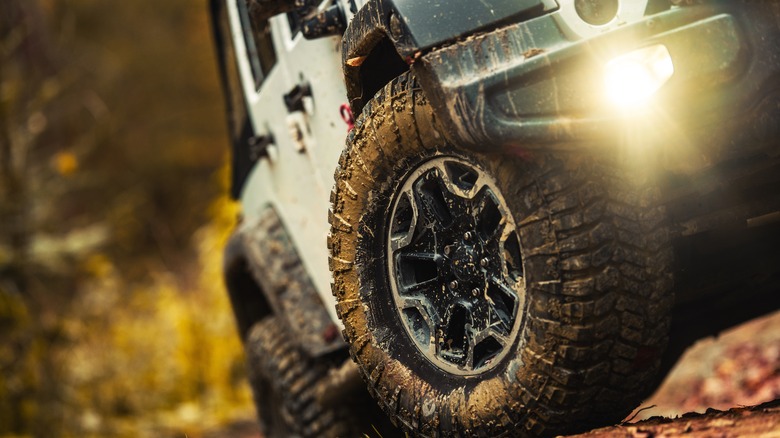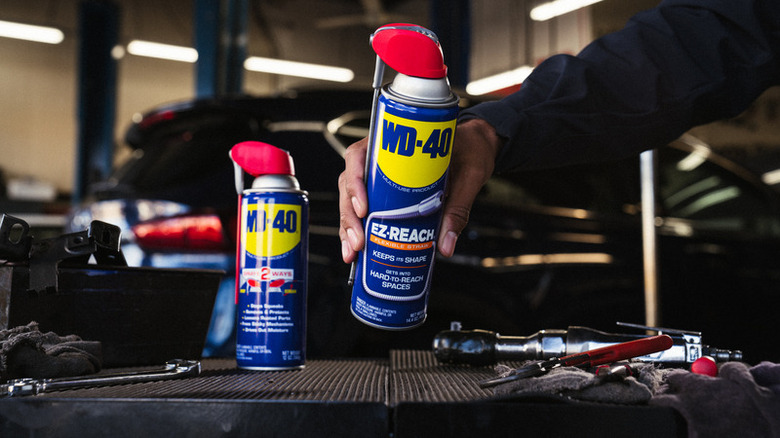Everything WD-40 Can Do To Help Keep Your Car In Tip-Top Shape
Many people have a can of WD-40 somewhere in their home for when they need to loosen a stuck bolt or use it as some other lubricant. However, the versatile product has many more uses than that, and can be especially helpful in the garage if you're looking for inexpensive ways to keep your car looking and running as good as new. Originally developed for use in the aerospace industry as a degreaser and rust-prevention solvent, WD-40 has many applications because of its low-viscosity, affordability, and how easy it is to use — often simply by spraying it straight from the canister.
It's important to remember that WD-40 is a brand with a variety of products that, while similar, also have some key differences — not every WD-40 variant will be suitable for every application. Always double check the instructions on the product before use. Automotive care can get pretty expensive, so it's best to prevent any problems before they occur. Furthermore, be mindful of which parts of your car you should never use WD-40 on, such as your engine belts and hot exhaust pipes. However, as long as you're careful how you use it, the product can actually save you money in the long run by helping you maintain your car in tip-top shape. Here's a few great ways it can be of use.
Prevent rust and corrosion
When it was first developed in the 1950s, the chemists working on WD-40 were looking to create a rust-prevention solvent. While there are certain things you can and can't do with your car using the product that these scientists eventually ended up with, WD-40 still maintains this rust-prevention quality.
It's particularly useful for both protecting the chrome parts of your car from rust and improving their shine. This can be done by coating the chrome surfaces with original WD-40 spray and then waiting for at least 10 minutes so it can sink in. Then, gently scrub the chrome before rinsing off the residue. Spray on another coat and wipe it down to add some shine to your chrome.
Similarly, WD-40 can be used to restore your vehicle's headlights. You'll want to use WD-40 Multi-Use Product, and instead of applying it directly to the lights as you would with chrome, you should spray it onto a clean cloth first. Then, thoroughly rub your headlights with this cloth to restore their shine.
Protect weatherstripping and loosen stuck and corroded components
If you've already got WD-40 in your garage or tool shed, chances are you bought it to loosen stuck bolts and hinges in your home. There's no reason why it can't be applied the same way with your vehicle — especially since that's exactly where you're likely to find small parts that have rusted stuck. This includes nuts and bolts in your engine block or other parts of your car, as well as hinges in your gas tank cap, glove compartment, and other doors. Corroded parts are some of the hardest to deal with, but by applying WD-40, you can have them loose in no time. Using WD-40 on your car doors can be particularly useful if you live in colder climates. If that's the case, you're probably no stranger to times when your doors or car windows become stuck due to the cold weather. WD-40 can be used to unstick them in these situations.
WD-40 can also keep your gaskets and the weatherstripping of your car pliant, which will extend their lifespans as well as keep the climate control of your car more efficient. The product can also be used in a similar fashion with your windshield wipers, slowing down their wear and tear and saving you money, as you won't have to replace them as often.
Lubricate door locks, hinges and more
One of the most common uses for WD-40 is as a lubricant, which makes it especially useful to keep your car in tip-top shape. Before parts become so corroded that they won't budge, you can take preventive measures by lubricating them with WD-40. Your vehicle has plenty of latches, and other mechanisms that can stick and become an annoying nuisance. For example, your hood may make a noticeable noise when you open and close it, which you can prevent by lubricating your hood latches with WD-40 Smart Straw — the straw makes it especially easy to get into the tight area and apply the oil where you really need it. Similarly, WD-40 can be used on door hinges, as well as door locks and other sliding mechanisms in both the interior and exterior parts of your vehicle.
Another way to use the product as a lubricant is on your strut mounts, which can become annoyingly squeaky when you drive on the open road. A very important word of caution, however: one part of your car where you should never use WD-40 as a lubricant is on your brakes. Squeaky brakes may be annoying, but they're an important warning sign that it may be time to replace your pads — the last thing you should do is ignore that warning by lubricating your brakes and disc rotors, which can severely compromise their performance and potentially result in a dangerous crash.
Remove residue, grease, and other unwanted substances without scratching paint
One of the most common ways people use WD-40 is to remove sticky residue from adhesives and similar substances. If you like to keep your car looking pristine — or just hate that sticky feeling on your dashboard or other areas that may get compromised — WD-40 can be extremely handy. For example, if you're the type of person who eats all the french fries out of the bag by the time you make it home from the drive-thru, your steering wheel likely has a layer of grease on it that you'll want to remove.
Another common adhesive you may want to remove is residue from leftover bumper stickers, whether they're for political candidates you no longer support, bands you no longer listen to, or from the vehicle's previous owner. If you've recently had young kids in your car, you may also notice stray crayon marks on your car's interior — WD-40 can also clean these up for you. The solvent is safe to use with paint. That means you can use WD-40 to remove grime, tree sap, bird droppings, dead bugs, or paint scuffs from other cars. Simply apply the oil and then wash it off with soap and water.
Remove moisture from flooded engines and prevent electrical issues
If you didn't already know, the "W" and "D" in WD-40 stands for water displacement. Oil and water don't go together well, and WD-40 is especially adept at keeping water away and preventing moisture in the parts of your car that you really want to keep dry. The electrical components of your vehicle are obviously some of the car parts that are important to keep moisture-free, and WD-40 can be used to dry them out, including spark plugs, spark plug wires, and ignition distributors.
Likewise, WD-40 Multi-Use Product can be used if you're dealing with a flooded engine, whether it's that of your car, lawnmower, tractor, or other vehicle. With the engine completely shut off, spray some original WD-40 formula directly into the carburetor. Once the moisture is clear, your engine should restart as if there was never any problem. While it's great for drying out flooded engines, just remember that WD-40 is not a substitute for engine oil, and you should refrain from ever using it as such.
Keep your car clean of mud, bugs, and more
Just as WD-40 can be used to remove the sticky residue left from stickers and other adhesives, it can also be used as a way to keep stubborn stains from sticking to your car in the first place. If you do a lot of highway driving and are sick and tired of having to stop to periodically clear your windshield of splattered bugs, you should try spraying WD-40 on the glass beforehand. Rather than stick to your windshield, when a bug comes into contact with your speeding vehicle it will instead slide off and become teeny-tiny roadkill. WD-40 can similarly be used as a preventive measure on your car's grill as well.
If you like to take your vehicle off the highway, or off the road altogether, then sticky mud may be even more of an issue than dead bugs. If that's the case, coat the most affected surfaces of your truck or car's exterior with WD-40. This will prevent much of the mud from collecting on your vehicle in the first place. Since WD-40 isn't harmful to automotive paint, you can also do this with your dirt bike, buggy, ATV, or any other vehicle you plan to take off-road and get messy with.
Keep tough-to-clean parts of your car looking new
WD-40 can also be used to clean your wheels and tires. It can be applied to your side walls as well as the full rubber surface of your tires. The penetrating oil can be used to remove brake dust and other grime from your wheels and give them a shiny luster to match your chrome. Other substances the product excels at removing include tar and oxidation residue. WD-40 is most useful for removing these stubborn materials and improving shine, but it should be used to complement and not fully substitute specialized wheel, tire, and paint cleaners that also include protective properties.
Other parts of your vehicle that may have similar stains — that you may not have considered using WD-40 to clean — are the carpets and upholstery. Rubber carpets will show off every bit of tar that you may track in, for example, and it's not hard for the upholstery of a brand new car to quickly amass greasy fingerprints, plus other stains and substances. WD-40 can even be used if chewed gum gets stuck in your upholstery. As with many other applications, spray the product first then gently rub with a clean cloth to remove these unwanted marks and materials.
